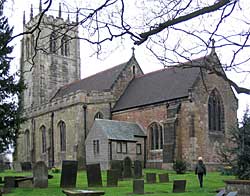Greasley
By A Stapleton
 St Mary's church, Greasley (photo: A Nicholson,
2004).
St Mary's church, Greasley (photo: A Nicholson,
2004).The original parish of Greasley, down to modern times, was, I believe, so far as this county is concerned, second only to the parish of Worksop in point of superficial magnitude. It comprised the six hamlets and constablewicks of Brinsley, Kimberley, Moorgreen, Newthorpe, Watnall Cantelupe, and Watnall Chaworth. Its limits also embraced Babbington Moor, Beauvale, Beggarlee, and the detached territory of Hempshill, as well as the sites of the present Hill Top and Lynn Croft. Hence, it is scarcely necessary to say, the old parochial registers are of greater size and importance than usual, and a similar remark is in some degree applicable to the churchyard memorials, whereon the several members of the ancient parish are fortunately reflected in a great many instances. The original state of affairs obtained down to 1838, when Brinsley Church was built, followed by that of Kimberley in 1847, each having its attached burial-ground. Hence, the continuation of some of the genealogical data chronicled in the parochial records and inscriptions of Greasley must be sought in those of the daughter parishes.
Naturally larger than the average, Greasley may no doubt be considered as, upon the whole, a good example of an English country churchyard, exhibiting so far, little or no signs of that modernisation so frequently destructive of antiquarian, sentimental, and picturesque features. It has never, apparently, been systematically levelled; neither have formal paths been laid out, except the necessary one from the main gate, and thence continued around the church. Uneven ranges of grassy hillocks cover the old-time villagers, ivy-clad tombs incline at varying angles, majestic trees—the summer haunt of many a feathered songster—beautify the open area, less stately growths find shelter by the church and churchyard walls, while a fine old yew graces the neighbourhood of the disused south porch. The description in Gray's immortal "Elegy written in a Country Churchyard" is peculiarly applicable:—
Beneath those rugged elms, that yew-tree's shade.
Where heaves the turf in many a mouldering heap;
Each in his narrow cell for ever laid,
The rude forefathers of the hamlet sleep.
Lying as it does on a hill, the land falls gently away from its south boundary-wall to form a verdant valley, separating the sacred area by some half-mile from the "New London" Colliery opposite. Hence, unlike the case of Wilford Churchyard, neither its quiet beauty nor its comparative solitude can be said to be materially marred by the intermittent sights and sounds of mechanical industry wonderfully softened by distance.
There is, however, no warrant for presuming this old-world state of affairs will continue always. Indeed, I was informed a suggestion had actually been made that all the old memorials should be removed from the body of the churchyard, and ranged along the boundary-walls. Such disencumbrance of the ground would unquestionably render available a plot of land admirably adapted for an effective display of landscape gardening, such as one may presume would supervene upon the revolution. On the other hand, however, the proceeding would involve the irrevocable effacement—so far as its essential and distinctive features are concerned—of one of our too few remaining unspoilt God's Acres, hallowed in association with the last rites over countless generations of villagers.
The foregoing remarks apply almost wholly to the south side of the church, where the edifice screens the ground from the Nottingham and Alfreton highway bounding it northward. Between the church and the road, indeed, the ground westward of the main path (apparently representing a modern extension) assumes more the character of a modern cemetery, in the style and number of the memorials, none of which are older than the late "seventies." However, this plot in turn would seem to have proved inadequate to parochial needs, in view of the recent provision of further burial accommodation. For this latter purpose, an extension in every way ideal would have been the absorption of a section of the aforementioned valley-slope, south of and adjoining the old churchyard, which however could not be obtained, unfortunately. Consequently, some few years ago, was acquired and consecrated a plot of ground lying westward of the churchyard, but separated from the latter by one public footway, and traversed by another.
ANCIENT AND INTERESTING.
To even the casual observer it will be patent that, in antiquity and general interest, the Greasley Churchyard memorials are fully equal to the average. Of them and their inscriptions probably many residents in the parish are possessed of considerable general knowledge, and indeed are acquainted with numerous details whereof the present writer must remain in ignorance. On the face of the proposition, therefore, it would appear little less than an impertinence for a stranger (whose only connection with the parish is represented by the circumstance that his ancestors were located there from one to three centuries ago) to propose enlightening them further. On every-day lines, of course, such a self-condemned proposition could not be entertained. Conversely, however, it may be conceded that no results of acquaintance, however intimate, with memorials as they stand, can compare with results obtainable from home-study of exhaustive transcripts, especially after the latter have been analysed and tabulated. Experience proves that the methodical handling of collective graveyard inscriptions infallibly brings to light many things equally new both to writer and reader — things in fact that would not otherwise have come to light at all. Furthermore, even among parishioners, there must be many to whom the epitaphs are little more than a sealed book, and who will welcome the opening of the book. Such then must be the compiler's excuses for submitting to the public the results of his examination of the Greasley inscriptions.
It is true that the Rev. Baron von Hube's history of the parish includes an interesting chapter on the churchyard, but the circumstance of that historian's labours being claimed by so extensive an area, naturally precluded the feasibility of such a detailed inspection of the memorials as is possible in the case of a separate worker. As a matter of fact, beyond the series of Barber memorials (entirely in prose), the Baron quoted but two others as being of general interest. In addition, I myself quoted some dozen Greasley epitaphs, as illustrative examples, in a little book, "The Churchyard Scribe," 1908. But the combined data contained in both works does no more than touch the fringe of the present subject, as it is hoped to show.
In July, 1907, the Rev. Baron von Hube, then vicar (under whose hospitable roof I had previously sojourned while transcribing the marriage registers), wrote me according permission to copy the churchyard inscriptions. I accomplished the task (omitting the plot of modern memorials previously referred to) during several visits to the spot in September-October of the same year, so far as proved feasible single-handed. Subsequent experience gained in the disused grounds of old Nottingham, however, emphasised the unsatisfactoriness of other than exhaustive work, while minimising apparent obstacles to that end. Hence, as there remained no adequate excuse for withdrawing my hand from the plough, in default of an earlier opportunity, I discharged the implied moral obligation in March-April, 1910. Engaging the capable assistance of Mr. Thomas Tatlow, sexton, I ultimately had the gratification of completing about 40 previously incomplete inscriptions—in addition to finding several overlooked memorials, and two or three subsequently erected examples, I doubt whether anybody is infallible in going over a large churchyard, insomuch that in most cases it would probably be safer for a second scribe to check the work of the first. Unfortunately, however, what ever may prove feasible in the future, when the value of churchyard inscriptions comes to be better recognised, no such plan is at present likely to fall within the scope of practical politics, in view of the extreme difficulty of finding even single volunteers for this class of work—duplicate operators being beyond the pale of any legitimate dreams. Though experience in the labours of transcription is discouraging to definite claims, I am now at least not conscious that any existing legible line, word, letter, or figure, inscribed in the older parts of Greasley churchyard, above or below ground, has escaped me. And now for a few definite particulars.
My transcripts, duly numbered, are copied from 321 memorials—a total wherefrom are of course excluded the few instances of bare initials, as well as the here very few examples of illegible items. With regard to period, the facile plan adopted in connection with the Nottingham memorials of dividing them between the eighteenth and nineteenth centuries, needs here to be somewhat extended in both directions, insomuch as portions of no less than four centuries are involved. However, it may sufficiently serve for the present to adopt the same dividing line, and so to record that no less than 86 legible Greasley memorials (or more than one-fourth of the total) carry dates wholly earlier than 1800, while 18 others fall astride the dividing line, so to speak, in the dates they carry. When slight and probably but arbitrary variants are excluded, it transpires that these Greasley inscriptions refer to 172 different surnames, plus 11 unduplicated surnames used as Christian names.
